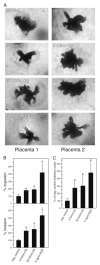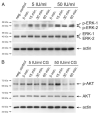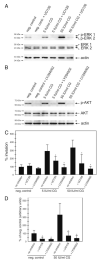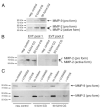Human chorionic gonadotropin stimulates trophoblast invasion through extracellularly regulated kinase and AKT signaling
- PMID: 18063683
- PMCID: PMC2974217
- DOI: 10.1210/en.2007-1282
Human chorionic gonadotropin stimulates trophoblast invasion through extracellularly regulated kinase and AKT signaling
Abstract
Chorionic gonadotropin (CG) is indispensable for human pregnancy because it controls implantation, decidualization, and placental development. However, its particular role in the differentiation process of invasive trophoblasts has not been fully unraveled. Here we demonstrate that the hormone promotes trophoblast invasion and migration in different trophoblast model systems. RT-PCR and Western blot analyses revealed expression of the LH/CG receptor in trophoblast cell lines and different trophoblast primary cultures. In vitro, CG increased migration and invasion of trophoblastic SGHPL-5 cells through uncoated and Matrigel-coated transwells, respectively. The hormone also increased migration of first-trimester villous explant cultures on collagen I. Proliferation of the trophoblast cell line and villous explant cultures measured by cumulative cell numbers and in situ 5-bromo-2'-deoxyuridine labeling, respectively, was unaffected by CG. Addition of the hormone activated ERK-1/2 and AKT in SGHPL-5 cells and pure, extravillous trophoblasts. Inhibition of MAPK kinase/ERK and phosphatidylinositide 3-kinase/AKT blocked phosphorylation of the kinases and attenuated CG-dependent invasion of SGHPL-5 cells. Similarly, the inhibitors decreased hormone-stimulated migration in villous explant cultures. Western blot analyses and gelatin zymography suggested that CG increased matrix metalloproteinase (MMP)-2 protein levels and activity in both culture systems. Inhibition of ERK or AKT diminished CG-induced MMP-2 expression. In summary, the data demonstrate that CG promotes trophoblast invasion and migration through activation of ERK and AKT signaling involving their downstream effector MMP-2. Because the increase of CG during the first trimester of pregnancy correlates with rising trophoblast motility, the hormone could be a critical regulator of the early invasion process.
Figures








Similar articles
-
Wingless (Wnt)-3A induces trophoblast migration and matrix metalloproteinase-2 secretion through canonical Wnt signaling and protein kinase B/AKT activation.Endocrinology. 2010 Jan;151(1):211-20. doi: 10.1210/en.2009-0557. Epub 2009 Nov 3. Endocrinology. 2010. PMID: 19887570 Free PMC article.
-
Transcription factor AP-2α promotes EGF-dependent invasion of human trophoblast.Endocrinology. 2011 Apr;152(4):1458-69. doi: 10.1210/en.2010-0936. Epub 2011 Feb 8. Endocrinology. 2011. PMID: 21303946
-
Expression, regulation and functional characterization of matrix metalloproteinase-3 of human trophoblast.Placenta. 2009 Mar;30(3):284-91. doi: 10.1016/j.placenta.2008.12.002. Epub 2009 Jan 19. Placenta. 2009. PMID: 19155066 Free PMC article.
-
The role of chorionic gonadotropin (CG) in blastocyst implantation.Arch Med Res. 2001 Nov-Dec;32(6):627-34. doi: 10.1016/s0188-4409(01)00330-7. Arch Med Res. 2001. PMID: 11750740 Review.
-
Human chorionic gonadotropin: Different glycoforms and biological activity depending on its source of production.Ann Endocrinol (Paris). 2016 Jun;77(2):75-81. doi: 10.1016/j.ando.2016.04.012. Epub 2016 May 10. Ann Endocrinol (Paris). 2016. PMID: 27177499 Review.
Cited by
-
Lipopolysaccharide induces cytokine production and decreases extravillous trophoblast invasion through a mitogen-activated protein kinase-mediated pathway: possible mechanisms of first trimester placental dysfunction.Hum Reprod. 2012 Jan;27(1):61-72. doi: 10.1093/humrep/der362. Epub 2011 Nov 3. Hum Reprod. 2012. PMID: 22052387 Free PMC article.
-
Diverse roles of prostaglandins in blastocyst implantation.ScientificWorldJournal. 2014 Jan 27;2014:968141. doi: 10.1155/2014/968141. eCollection 2014. ScientificWorldJournal. 2014. PMID: 24616654 Free PMC article. Review.
-
Extragonadal actions of chorionic gonadotropin.Rev Endocr Metab Disord. 2011 Dec;12(4):323-32. doi: 10.1007/s11154-011-9193-1. Rev Endocr Metab Disord. 2011. PMID: 21845366 Free PMC article. Review.
-
Granulocyte colony-stimulating factor (G-CSF) upregulates β1 integrin and increases migration of human trophoblast Swan 71 cells via PI3K and MAPK activation.Exp Cell Res. 2016 Mar 15;342(2):125-34. doi: 10.1016/j.yexcr.2016.03.005. Epub 2016 Mar 15. Exp Cell Res. 2016. PMID: 26992288 Free PMC article.
-
Epidermal growth factor-like domain 7 promotes migration and invasion of human trophoblast cells through activation of MAPK, PI3K and NOTCH signaling pathways.Mol Hum Reprod. 2015 May;21(5):435-51. doi: 10.1093/molehr/gav006. Epub 2015 Feb 9. Mol Hum Reprod. 2015. PMID: 25667199 Free PMC article.
References
-
- Pierce JG, Parsons TF. Glycoprotein hormones: structure and function. Annu Rev Biochem. 1981;50:465–495. - PubMed
-
- Tulchinsky D, Hobel CJ. Plasma human chorionic gonadotropin, estrone, estradiol, estriol, progesterone, and 17α-hydroxyprogesterone in human pregnancy. 3. Early normal pregnancy. Am J Obstet Gynecol. 1973;117:884–893. - PubMed
-
- Rao CV, Lei ZM. The past, present and future of nongonadal LH/hCG actions in reproductive biology and medicine. Mol Cell Endocrinol. 2007;269:2–8. - PubMed
-
- Shi QJ, Lei ZM, Rao CV, Lin J. Novel role of human chorionic gonadotropin in differentiation of human cytotrophoblasts. Endocrinology. 1993;132:1387–1395. - PubMed
-
- Han SW, Lei ZM, Rao CV. Treatment of human endometrial stromal cells with chorionic gonadotropin promotes their morphological and functional differentiation into decidua. Mol Cell Endocrinol. 1999;147:7–16. - PubMed
Publication types
MeSH terms
Substances
Grants and funding
LinkOut - more resources
Full Text Sources
Other Literature Sources
Miscellaneous

